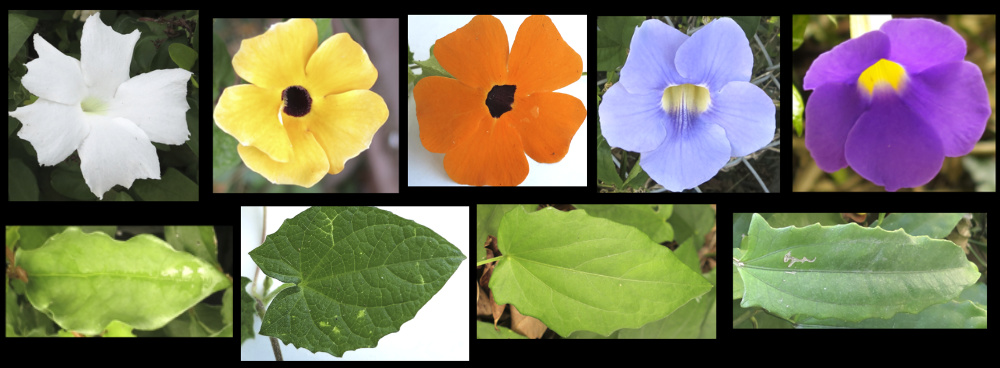Thunbergia.
The Thunbergia genus, previously in Thunbergiaceae is now the sub-family Thunbergioideae
in Family Acanthaceae s.l.
There are around 100 (200) species some of which are very variable.
Australia has 4 species of which 1 is a native and the others are naturalised including one in S.E. Queensland.
They are small shrubs, or vines that are prostrate or climb by twining.
The opposite leaves are on petioles.
The blades are typically oval to lanceolate with a pointed tip.
The base may be wedge-shaped or lobed (hastate or sagittate).
The edge may be toothed or lobed.
There may be hairs but there are no cystoliths.
Axillary inflorescences are mostly a solitary flower but there may be up to 4.
They have a long peduncle and 2 large bracts (sometimes called bracteoles) that enclose the calyx.
The corolla is trumpet-shaped with a long tube and radially or slightly bilaterally symmetric lobes.
They come in white plus yellow, orange, blue and shades of purple and mauve.
The calyx may have a flat or slightly lobed top or up to 20 narrow sepals.
The corolla has a tubular section that is slightly curved and wider at the throat.
The 5 lobes are roughly equal in size and spread outwards.
There may be short hairs on the corolla.
The 4 stamens, inserting near the base of the corolla are in 2 pairs of unequal lengths.
There is a nectiferous disc around the base of the superior ovary.
The ovary has 2 locules each with 2 ovules that are side by side.
The 2 thin lobes of the funnel-shaped stigma may be equal or unequal in size.
The fruit are loculicidal capsules with a beak at the top.
The 4 seeds are smooth or ridged.
Some are used in gardens and there are a few cultivars.
J.F.


